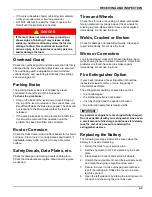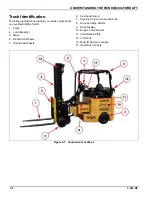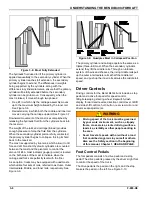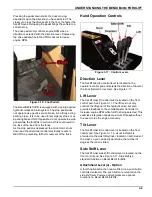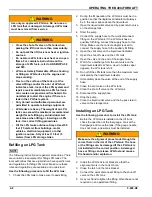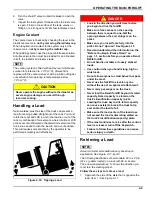
UNDERSTANDING THE BENDI B40I4 FORKLIFT
3-11
Understanding Stability
DANGER
The leading causes of accidents involving forklift trucks
are due to the lack of understanding how forklift trucks
operate, especially when it comes to stability.
DANGER
Basic Principles
The concepts concerning stability are relatively easy to
understand. As the angle between the forks and the body
of the truck approaches 90° to the right (See Figure 3-14)
or left (See Figure 3-15), the truck is in its least stable
position. Unlike an automobile which has four points of
suspension, the Bendi B40i4 forklift truck operates on a
three-point suspension. When the forks are turned nearly
90° to the right, two of the suspension points are on the
rear axle (item 1) and (item 2). The third suspension point
is the center point of the front wheel (item 3). The center
of gravity, an imaginary point at which all of the truck’s
weight is concentrated, is located as shown (item 4)
when:
• The forks are turned nearly 90° to the right.
• No load is placed on the forks.
• The truck is at rest.
In this position, the fulcrum, or axis around which the
truck will tip, is between suspension point (item 2) and
(item 3).
• If you try to pick up a load that is too heavy, the truck
will tip around the fulcrum. Imagine a triangle (item 5),
drawn between the three suspension points.
Figure 3-14: Right View 90° Stability
This triangle is commonly called the stability triangle.
Since the center of gravity is an imaginary point, it will
shift for various reasons. The crucial thing to remember
is, as long as the center of gravity of the truck remains
within the border of the stability triangle, the truck will not
tip. If the center of gravity shifts so it falls outside of the
border of the stability triangle, the truck will tip around the
fulcrum.
Again, imagine a triangle, drawn between the three
suspension points. The forklift is most vulnerable in three
conditions: See Figure 3-15.
1.
When the forks are loaded, the load is shifted to the
left, and the forks are straight ahead, the center of
gravity moves to a point along the axis between
points (1) and (3).
2.
When the forks are loaded, the load is shifted to the
right, and the forks are pivoted 90° to the right, the
center of gravity moves to a point along the axis
between points (2) and (3).
3.
When the forks are loaded and the load is too heavy
or not properly distributed, the center of gravity
moves to a point along the axis between points (1)
and (2).
• Never load a lift truck beyond its rated
capacity. Loading beyond rated capacity can
cause axles to break, trucks to tip over, loads
to fall, causing serious injury or death. See
identification plate for rated capacity and load
center information.
• Never allow anyone to stand beneath or pass
under the lifting mechanism.
• Make sure that the load is centered and the
forks are fully engaged.
• Failure to do so can cause the load to fall, or
the truck to tip over, resulting in serious
injury or death
If you don’t understand the concepts of stability,
you run the risk of tipping over the Bendi B40i4
forklift truck, which can cause serious injury or
death.
Summary of Contents for Bendi B40i4
Page 2: ......
Page 12: ...1 4 F 808 R0 FORKLIFT SAFETY AND FAMILIARITY Figure 1 2 Decals...
Page 18: ...1 10 F 808 R0 FORKLIFT SAFETY AND FAMILIARITY Table provided for general use NOTES...
Page 24: ...2 6 F 808 R0 RECEIVING AND INSPECTION Table provided for general use NOTES...
Page 54: ...4 16 F 808 R0 OPERATING THE B40I4 FORKLIFT Table provided for general use NOTES...
Page 62: ...5 8 F 808 R0 Figure 5 5 Lubrication Points...
Page 64: ...5 10 F 808 R0 Table provided for general use NOTES...

